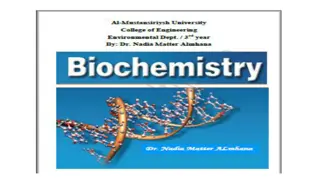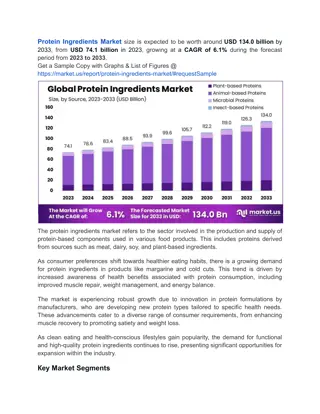Optimizing Glycoprofiling Analytical Method for Therapeutic Proteins
Glycoproteins play a significant role in biopharmaceuticals, necessitating detailed characterization due to their structural heterogeneity from glycosylation. This study focuses on developing a robust and cost-effective characterization method using a Definitive Screening Design to optimize an HPAE-PAD method. The experiment involves manipulating factors such as initial %NaOAc, %NaOH, and gradient parameters to enhance glycoform peak identification. The ultimate goal is to ensure consistency and quality of glycoprotein therapeutics through effective glycosylation analysis techniques.
Download Presentation

Please find below an Image/Link to download the presentation.
The content on the website is provided AS IS for your information and personal use only. It may not be sold, licensed, or shared on other websites without obtaining consent from the author.If you encounter any issues during the download, it is possible that the publisher has removed the file from their server.
You are allowed to download the files provided on this website for personal or commercial use, subject to the condition that they are used lawfully. All files are the property of their respective owners.
The content on the website is provided AS IS for your information and personal use only. It may not be sold, licensed, or shared on other websites without obtaining consent from the author.
E N D
Presentation Transcript
Optimizing a Glycoprofiling Analytical Method for Therapeutic Proteins using Definitive Screening Designs and Generalized Regression+ +A longer version of this talk can be found at https://tinyurl.com/Prague-SEB-Conference Eliza Yeung, Ph.D. Associate Director of Process Characterization Cytovance Biologics, Inc 800 Research Parkway, Ste 200 Oklahoma City, OK, USA eyeung@cytovance.com Philip J. Ramsey, Ph.D. Department of Math. and Stat. University of New Hampshire North Haven Group, consultancy Durham, NH, USA Cell: +1-315-3518 philip.ramsey@unh.edu
Glycosylations are Critical Quality Attributes Glycoproteins are the largest group of biologically-derived drugs. ICH Q6B guideline requires extensive physiochemical characterization of biopharmaceuticals including inherent structural heterogeneity due to glycosylation (post-translationally modified) and lot-to-lot consistency is required. Carbohydrate content. biantennary triantennary tetrantennary Carbohydrate chain structure. Oligosaccharide pattern (antennary profile). High-Mannose Complex-types Glycosylation site. Common types of N-glycans. UPS General Chapter <1084>. Currently, there is a lack of a universally accepted analysis technique for glycosylation characterization. (C)2017 Cytovance/Philip J. Ramsey, Ph.D. 2
Glycosylations are Critical Quality Attributes The goal is to develop a robust, cost effective characterization method. A Definitive Screening Design was used to optimize an HPAE-PAD1 method. The approach uses a glucose ladder (GU) as a reference to identify glycoform peaks from an actual human antibody sample. 10.0 Glycoform glycan G-Unit GU=11 GU=9 GU=1 Neutral GU=3 7.5 GU=2 GU=8 GU=10 GU=7 A 3.59 AB 5.0 C B 3.89 GU=6 2.5 GU=5 Response C 4.23 0.0 D D 4.42 -2.5 E 9.17 GU=4 F 10.8 -5.0 human IgG Glucose ladder -7.5 E F Charged 1High Performance Anion Exchange Chromatography with Pulsed Amperometic Detection -10.0 0 10 Neutrall 20 30 40 50 Time (min) Charged (C)2017 Cytovance/Philip J. Ramsey, Ph.D. 3
Designing the Experiment Five factors were selected to manipulate in the experiment. Factor (level) -1 0 1 Initial %NaOAc (% A) 0 10 20 Initial %NaOH (% B) 30 40 50 Gradient_01 (mM NaOAc /min) Gradient_02 (mM NaOAc /min) Gradient_03 (mM NaOAc /min) 0.415 1.25 2.085 1.25 2.085 2.915 4.72 5.555 6.39 * Gradient_01, _02 and _03 are % A (500 mM NaOAc) increases over 12 min, 12 min and 18 min respectively and at constant initial % B (200 mM NaOH,10 mM NaOAc). The values are expressed as mM NaOAc per min. (C)2017 Cytovance/Philip J. Ramsey, Ph.D. 4
Designing the Experiment Seven responses were chosen to optimize in the experiment. Retention Time for unit 3 (RT_03) was most important Response RT_G03 Resol_G03 Resol_G04 Resol_G05 Resol_G09 Resol_G10 USP Tailing USP Tailing G04 Description Retention Time Resolution G03-G04 Resolution G04-G05 Resolution G05-G06 Resolution G09-G10 Resolution G10-G11 Optimization Target ~ 8.5 min Maximize Maximize Maximize Maximize Maximize Monitor (0.8-1.2) (C)2017 Cytovance/Philip J. Ramsey, Ph.D. 5
Analyzing the Experiment A central composite design (CCD) was performed in tandem in order to validate the DSD approach may be useful for GMP purposes. The DSD can estimate all main effects, quadratic effects and some subset of two-factor interactions assuming effect sparsity. For five factors there are a total of 20 potential experimental effects, but only 13 unique settings of factors in the DSD; therefore the design is supersaturated for a full quadratic model. What subset of effects best predict HPAE-PAD performance? We explore two approaches using the Fit Model platform in JMP: 1. All Possible Models 2. Generalized Regression (JMP Pro only) (C)2017 Cytovance/Philip J. Ramsey, Ph.D. 6
All Possible Models Below is a plot of the All Possible Models AICc values vs model size for RT_03; smaller values indicate better predictive models. Models with 4 to 6 effects seem to be the best based on AICc. A Fit Group was formed with a subset of models in this size range. The 4 effect model, annotated in the plot, was eventually selected as best. (C)2017 Cytovance/Philip J. Ramsey, Ph.D. 7
Generalized Regression JMP Pro Next a model was selected using Generalized Regression with the Double Lasso fittingoption and the ERIC criterion see JMP Help for details. Below are the best All Possible Models and the best Gen Reg model using the DSD and then the best Gen Reg model using the CCD the three models are quite similar. (C)2017 Cytovance/Philip J. Ramsey, Ph.D. 8
Validation of the DSD Models A subset of the better predictive models were saved to a JMP Formula Depot and then applied to the CCD data for cross validation. The Model Comparison platform was used to perform the validation. The four effect model from the All Possible Models analysis has a lower Root Average Square error (RASE), indicating a smaller validation error. The Gen Reg four effect model may have slight lack of fit see the Actual by Predicted plot. (C)2017 Cytovance/Philip J. Ramsey, Ph.D. 9
Optimization of HPAE-PAD Method Both four effect models were then used in the Profiler to find optimum settings of the inputs to achieve a target of 8.5 minutes for RT_03. Both models generate similar optimum settings. Since we are matching a target response value, no unique solution exists. (C)2017 Cytovance/Philip J. Ramsey, Ph.D. 10
Optimization of the HPAE-PAD Method Optimized Settings for all responses. A similar modeling exercise was conducted for each response. Based on the DSD runs. The recommended settings to optimize all of the responses simultaneously. (C)2017 Cytovance/Philip J. Ramsey, Ph.D. 11
Optimization of the HPAE-PAD Method The predicted responses are also very close for the two designs. One can see that the predicted responses at the optimum settings are close; optimizations done separately for each response. Based on the model with the smallest validation error for each response. DSD Optimum CCD Optimum Response 2*(Std. Errors) RT_03 8.50 8.50 0.60 Resol_03 8.38 8.68 2.40 Resol_04 8.80 9.97 1.20 Resol_05 8.37 7.73 1.00 Resol_09 4.69 4.14 1.20 Resol_10 3.78 3.54 0.66 (C)2017 Cytovance/Philip J. Ramsey, Ph.D. 12
Conclusions Robust analytical methods are required by QbD for GMP in Biopharmaceuticals and in general for sound research results. Definitive Screening Designs are a cost effective type of experimental design that can be used to characterize and optimize analytical methods or many physical phenomena. In this presentation we have shown that the DSD performed as well as the CCD in optimizing the HPAE-PAD despite having approximately half the total number of experimental trials. Note: When substantial amounts of observational data are available, the methods shown in this talk can often still be used. (C)2017 Cytovance/Philip J. Ramsey, Ph.D. 13























